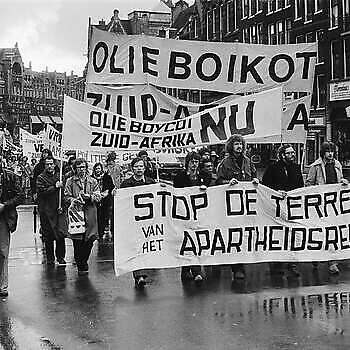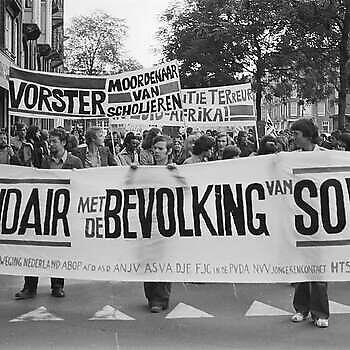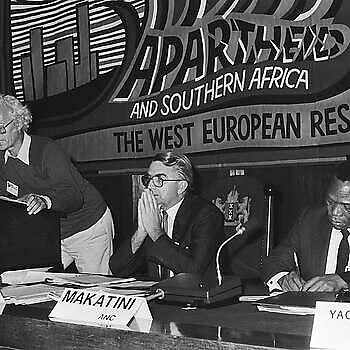In 1948, Daniël François Malan became the Prime Minister of the first apartheid government in South Africa. During Malan's tenure, it was Hendrik Verwoerd, the Minister of Native Affairs, who drafted the apartheid laws. The enforcement of these laws involved categorizing different 'races,' with black people being considered the least developed.
There was also significant resistance to the apartheid laws, primarily led by the African National Congress (ANC), with Nelson Mandela as its leader. After numerous protests, including those by other organizations like the Pan Africanist Congress (PAC), Nelson Mandela was arrested in 1964 on charges of terrorism and sabotage and was banished to Robben Island.
Cultural Agreement
After Malan became Prime Minister, the Netherlands decided that the apartheid laws were an internal matter for South Africa and should not be interfered with by the outside world. South Africa also supported the Netherlands' stance that the decolonization of Indonesia and New Guinea were internal issues.
On May 31, 1951, a cultural agreement was signed, formalizing friendly relations and the intended exchange and cooperation on paper. Nevertheless, criticism of apartheid policies in South Africa grew in the Netherlands and the rest of the world. In 1957, the Committee on South Africa (CZA) was established in the Netherlands, which raised funds for anti-apartheid organizations in South Africa. However, initially, the committee did not do much more than that.
Sharpeville
On March 21, 1960, a massacre occurred in Sharpeville, where 69 peaceful demonstrators were killed by police bullets. In response to this, the CZA (Committee on South Africa) was revived. For the Netherlands and the rest of the world, this was a turning point in the anti-apartheid movement in South Africa. There were global calls for an economic boycott. The CZA organized the first Dutch boycott action in 1964 against South African products, with the participation of, among others, the Labour Party (PvdA).
However, the Dutch government still did not take steps, despite a motion submitted by PvdA faction leader Jaap Burger in parliament. According to the government, it remained a domestic matter. In 1961, the Netherlands did vote for an anti-apartheid resolution at the United Nations, but only because it needed the support of African countries for its plans concerning New Guinea. In 1963, the Netherlands also voted for a United Nations arms embargo against South Africa, but this embargo was not binding.
In 1963-’64, the trial of the key ANC leaders, including Nelson Mandela, took place in South Africa, which increased interest in the anti-apartheid struggle in the Netherlands. In 1964, the International Defence and Aid Fund (IDAF) was established, with its Dutch branch founded in 1965 by the CZA. The Dutch government donated 100,000 guilders. Through a public campaign, they attempted to double this "Luns ton," which succeeded. Joseph Luns was the then Minister of Foreign Affairs. However, because the South African government banned the IDAF organization (labeling it as communist), the Dutch government withdrew its direct contribution to IDAF. The money was then transferred to the United Nations Trust Fund for Southern Africa, from where it eventually reached IDAF.
Boycott
The resistance in the Netherlands against apartheid primarily gained momentum from grassroots initiatives rather than the government. Some within Dutch society believed that the CZA (Committee on South Africa) was not doing enough, leading to the emergence of various new organizations/initiatives such as the Boycott Outspan Aktie (BOA) to protest the import of South African oranges, Kairos, an initiative from religious circles, and the Anti-Apartheid Movement Netherlands (AABN).
Kairos, for instance, focused its attention on Shell. The British-Dutch company held significance in both the Netherlands and South Africa. Shell had also continued its operations in Rhodesia for years, despite a mandatory oil embargo imposed by the UN on the country. Shell claimed that it had no influence over its subsidiary in Rhodesia.
The Dutch government still took limited steps and remained in favor of 'dialogue' rather than taking firm actions. Even after a progressive government under Prime Minister Den Uyl (PvdA) came to power in the Netherlands in 1973, the government remained reserved about sanctions. Additionally, by the end of 1975, there was a heated debate about supplying nuclear reactor vessels to South Africa. Refusing this supply was claimed to have been detrimental to employment in the Netherlands, and the issue nearly led to a government crisis. Ultimately, the situation resolved itself when the vessels were purchased by another party.
Soweto
On June 16, 1976, a protest in Soweto was brutally suppressed by the apartheid police. This once again became a turning point on a global scale, including for the Dutch government. As a result, in 1977, the Netherlands supported a mandatory arms embargo against South Africa at the United Nations. Additionally, the Netherlands voted for resolutions aimed at ending foreign investments and imposing an oil embargo. Subsidies for emigration to South Africa were discontinued, government support for exports to South Africa was halted, and the cultural agreement with South Africa from 1951 was frozen.
Various Dutch anti-apartheid and anti-colonialism movements decided to join forces during this time and formed the Committee for Southern Africa (KZA), not to be confused with the previously disbanded CZA. The KZA began as the Angola Committee, established in 1961 in response to Portuguese oppression in the country. In addition to Angola, the KZA also supported liberation movements in Guinea-Bissau, Mozambique, and South Africa. The KZA campaigned for the oil boycott, with the aim of boycotting Shell. Nevertheless, the government refused to investigate Shell's activities in South Africa. Therefore, a parliamentary committee began its own investigation at the end of 1978. This investigation was concluded in 1982, with the conclusion that the Dutch state had done nothing to block illegal oil supplies.
Internationally, the idea of an oil embargo gained more and more support. On March 21, 1979 (Sharpeville Day), a major KZA/Kairos campaign was launched. However, the Van Agt government attempted to counter the oil embargo with various alternative proposals. One such plan involved definitively ending the 1951 cultural agreement, and another announced visa requirements that could be used to deny South Africans entry to the Netherlands if deemed necessary.
Humanitarian Aid
The Dutch government had been providing 'humanitarian aid' to the ANC since 1975. However, anti-apartheid movements viewed this assistance as hypocritical. Despite the arms embargo, the Netherlands provided transport and communication equipment to the anti-apartheid movement for 'civilian use.' But this aid couldn't be given bilaterally because the ANC could potentially use it for military purposes. Officially, no support was provided to the ANC but to 'refugees in training centers managed by the ANC,' including those in Swaziland and Tanzania. The funds were transferred at the request of the ANC through the KZA (Committee for Southern Africa).
The Dialogue
In the early 1980s, the Netherlands decided to stop independent economic sanctions against South Africa and instead made its boycotts contingent on international agreements. They reverted to a policy of dialogue. South African organizations would only receive assistance if they were considered 'legal organizations' by the South African government. This effectively excluded most anti-apartheid organizations from receiving aid. Thanks to Eegje Schoo (VVD), who was Minister for Development Cooperation from 1982 to 1986, the ANC and SWAPO continued to receive humanitarian aid. For instance, the Dutch Development Organization SNV, which then fell directly under the Ministry for Development Cooperation, provided teachers for schools at the ANC camp in Morogoro, Tanzania.
In the summer of 1985, South Africa declared a state of emergency as the situation in the country escalated. Thousands of people, including children, were detained by the apartheid regime. This led to increased international pressure for further sanctions, but the Dutch government still did not take the lead and was unwilling to do so. Ultimately, in September 1985, the European Union adopted a package of measures, but many of these measures were already in effect.
It wasn't until 1990 that the situation in South Africa began to change, with De Klerk as president. He decided to no longer ban organizations like the ANC, and various measures, such as media restrictions, were (partially) lifted. Nelson Mandela was also released from prison on February 11, 1990, after 27 years. In 1994, democratic elections were finally held in South Africa, which went relatively peacefully and were convincingly won by the ANC. Nelson Mandela became president and formed a cabinet that enthusiastically initiated the (gradual) transition to the new 'Post-Apartheid South Africa' without crippling the (thriving) economy.
Dutch Bilateral Cooperation with South Africa after 1994
The first Dutch policy discussions with the New South Africa took place in 1995 under the leadership of Minister Pronk. In the lead-up to the elections, the Dutch government had strengthened its embassy in Pretoria. Jan Pronk, who had returned as Minister for Development Cooperation in 1994, ensured that individuals with experience in development cooperation were appointed, enabling the embassy to provide support for the elections and the establishment of the reconciliation-focused Truth and Reconciliation Commission (led by Bishop Tutu), as well as a range of policy areas deemed relevant for a peaceful transition to majority rule in a racially divided nation.
The intention was for the aid cooperation with South Africa to be of short duration. It was not the intention to include South Africa in the list of focus countries or program countries, which were nations with which the Netherlands had a very long-term aid relationship. In that period, the SADC region, of which South Africa was a part, included four countries with which the Netherlands maintained such a development cooperation relationship: Mozambique, Tanzania, Zambia, and Zimbabwe. Additionally, the Netherlands provided support to the SADC, the regional cooperative organization of countries in Southern Africa. This assistance was primarily focused on the so-called Beira Corridor. This program had been initiated during the apartheid regime and was intended to make the region less dependent on South African ports for its imports and exports.
The decision to temporarily grant South Africa partner country status had both a political and historical background. The active involvement of civil society in the Netherlands in the struggle against the apartheid regime played a significant role, as did the pressure exerted by them to assist the country in its reconstruction efforts. The historical ties between the two countries also played a part. Lastly, South Africa's potential role model status in Africa factored into the equation. The willingness to cooperate between the Netherlands and South Africa was substantial due to the large anti-apartheid movement within the Netherlands. Many individuals who had fought against the apartheid regime in South Africa were now part of the South African government and had established strong connections with the Netherlands during their struggle.
South Africa did not meet the criteria used for structural bilateral aid. Its per capita income was well above that of the so-called Least Developed Countries (LDCs). The institutional capacity of government organizations was generally well-established. These characteristics of South Africa significantly shaped the landscape for donors. For instance, foreign aid to South Africa in the second half of the 1990s amounted to only 5 percent of the government budget. This was a small fraction compared to most other aid-receiving countries in Africa, where it sometimes formed half of the government budget. This indicates that financially, aid was not a matter of life and death for South Africa. There was also no real need for large-scale technical assistance given the relatively well-functioning institutions in the country.
Reforming the Institutional Framework
During the initial policy discussions, it was decided to primarily focus Dutch cooperation on the field of justice in the Netherlands. One of the major challenges post-Apartheid was the reform of the institutional apparatus. Additionally, there was a need for a shift in culture from oppression to respect for human rights. The challenges mainly revolved around three areas: making the legal system serve poverty alleviation, increasing access to justice, and combating crime.
In the 1990s, support for youth policy (development of juvenile justice, reform of youth care, and addressing youth unemployment), local governance, land reform, and education were added to the justice sector. Gender became a cross-cutting theme. The Netherlands primarily followed South Africa's lead in selecting these sectors. Official Development Assistance (OS) funds were also used to support organizations combating the AIDS epidemic and violence against women, as well as those trying to improve urban development. The economic department of the Dutch embassy was strengthened, an agricultural counselor was included in the embassy, and funds were made available to stimulate the cultural sector, especially in townships and informal settlements. Kairos played a significant role in organizing visits between Dutch and South African (youth) organizations, fostering mutual learning about youth policy approaches.
Initially, the aid primarily consisted of project support. Under pressure from South Africa and due to changes in Dutch OS policy, the aid approach gradually shifted towards sector and budget support, with more responsibility placed on the recipient for implementation. The goal was to reduce the fragmentation (both sectoral and project-based) and streamline the program, as it was colloquially referred to as "cleaning up scattered assets" and "cutting deadwood."
In the justice sector, this new approach led to broad sector support for the E-Justice program, aimed at increasing access to justice for all South Africans, especially vulnerable marginalized groups. The program primarily focused on strengthening the institutional apparatus, particularly in terms of automation. However, the emphasis shifted to hardware, with less attention given to software such as personnel training. The question arose whether this was the best strategic choice within the sector. Later, measures were taken to refocus Dutch support more on poverty alleviation and human rights, including support for an umbrella organization of thousands of grassroots legal aid offices.
In 2004, it was decided to continue what had started as a temporary collaboration. Between 2003 and 2015, the Netherlands also invested in over 40 projects in South Africa in financial services, the aircraft industry, transportation, biotechnology, information technology, and the software sector. It wasn't until around 2015 that the decision was made to phase out the collaboration and replace it with a more trade and investment-oriented relationship. The total scale of Dutch assistance to South Africa over the past 25 years is estimated to have been in the range of over half a billion euros.
Collaboration at the Municipal Level
Several Dutch municipalities believed that the Dutch government was not taking sufficient action against the apartheid regime in South Africa at the national level. Therefore, in 1988, the Local Authorities Against Apartheid (LOTA) was established. The members of this organization were Dutch municipalities, and their policies went beyond those of the government. For example, the government did not want to implement a boycott unless it was done at the EU level. In that case, the impact of such a boycott would be too small, and there was also the possibility that South Africa might choose another country as a trading partner.
LOTA was an initiative of the KZA. In addition to boycotting South African products, LOTA also advocated for changing street names in the Netherlands if they were associated with South African Boer leaders. The goal was to change these names to those of resistance fighters against apartheid. In January 1993, LOTA's work was taken over by the Association of Netherlands Municipalities (VNG), and the name LOTA was changed to the Municipal Platform Southern Africa. VNG was a municipal platform active in Eastern Europe, where it contributed to peace policies. Additionally, it fought against apartheid in South Africa. However, it wasn't until 1993 that VNG truly engaged in the South Africa debate, as it had long been considered a "too political issue."
After Nelson Mandela was elected president, various initiatives were established in South Africa in collaboration with VNG. Firstly, there was Civics, which focused on developing civic organizations in townships. Additionally, there was cooperation between the Ministry of Housing, Spatial Planning, and the Environment (VROM), the Ministry of Housing in South Africa, Edes, and VNG. These parties aimed to stimulate housing construction for middle and low-income groups in South Africa. Lastly, the Ministry of Foreign Affairs worked with VNG to exchange technical knowledge at the municipal level, such as urban planning, waste management, and involving the population in these changes. VNG carried out these activities on behalf of the Ministry of Foreign Affairs and also extended them to other countries in addition to South Africa.
In 1995, the first municipal elections took place in South Africa, which further facilitated cooperation with VNG. Former employees of the Civics program were sometimes elected as mayors, making collaboration even smoother. As a result, genuine municipal ties developed between municipalities in the Netherlands and South Africa. VNG remained active in South Africa until 2012. After that, South Africa was no longer considered one of the "target countries," and the focus between the Netherlands and South Africa shifted more towards improving the trade relationship.
The AABN and the KZA had been in a long-standing rivalry and eventually merged (along with the Eduardo Mondlane Foundation) to form the Netherlands Institute for Southern Africa (NiZA). After the abolition of apartheid, NiZA's focus shifted to development work instead of apartheid. In 2012, the name of NiZA was changed to ActionAid Netherlands.
Sources:
- Dutch Development Cooperation 1949-1989
- Apartheid 1948 - 1990. Historiek
- Wikipedia about Apartheid in South-Africa
- The Netherlands and South-Africa deepen their relationship (2015)
- International Institute for Social History
- Cultural Treaty between The Netherlands and South-Africa
- Wikipedia Sietse Bosgra
- ActionAid's History
Thanks To:
- Janny Poleij
- Arie van der Wiel
- Hans Buis


